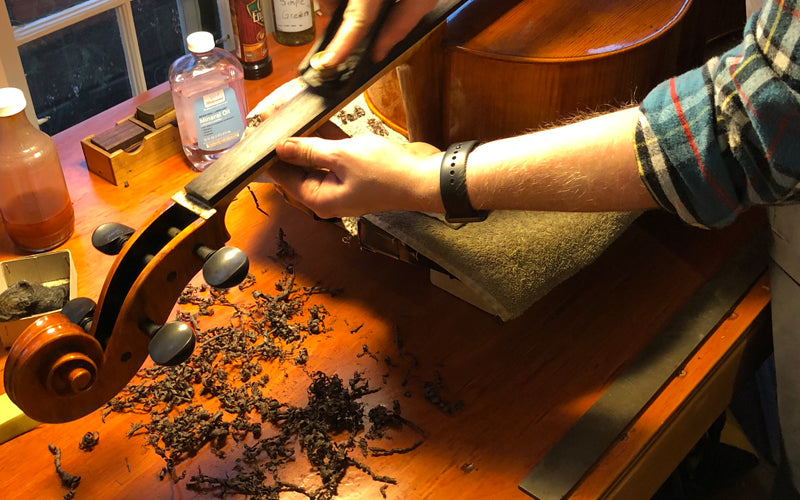Choosing the correct size violin, viola, or cello
How to Choose the Right Size Violin, Viola & Cello
Choosing the correct size instrument is not only an issue for children, but for adults as well. Since most children receive instruction from their string teachers or orchestra directors on sizing, we're going to concentrate this article on the neglected group — adults who might be small of stature (but mighty in personality, of course!).
Knowing what size cello or violin you need is the first step in getting an instrument that's comfortable to play — and comfort is key when it comes to mastering your craft and enjoying the experience of making music. Fortunately, whatever size you may be, there's a perfect size violin for you. At StringWorks, we've helped thousands of musicians find their ideal instrument through our 14-day in-home trial program and expert consultations. Read on to discover how to measure yourself so you can get a violin or cello that suits you perfectly.
Choosing Violin Size
Many smaller adults wonder if they need to play on a 3/4 size instrument because they're unaware of the range of sizes available, or feel that full size (4/4) is too large. The range of adults who can play on a full-size violin is far greater than for viola or cello. Nearly all violinists should have little trouble playing full-size (4/4) violins. For those who have extremely short fingers, there are 7/8 size violins available. Please inquire with us or your favorite violin shop about these instruments.
When selecting your violin, consider whether you need a complete setup. Many players benefit from purchasing a violin outfit that includes a properly sized case and bow. For new players, our beginner violin collection offers excellent options, while advancing musicians may prefer our intermediate violins for enhanced tone and playability.
Choosing Viola Size
For violas, sizes appear as a length of inches or as a fraction. Those inches represent the length of the back without considering the "bump" at the center — the button, or heel — but measuring beside it, straight down. These ranges are from 13 inches, which is the same as a 3/4 violin but is mostly reserved for children due to a drop in tonal quality, to 17", but few play such large sizes, with the majority of violists favoring 15.5" to 16.5."
For smaller adults, aim for 15" to 15.5," which is basically the equivalent to a 3/4 to 7/8 size violin, as you want to play as large an instrument as you can comfortably play, but never one too large as to harm you physically. Our viola collection includes detailed measurements for each instrument, and you can learn more about how viola size affects sound in our instrument anatomy guide.
Choosing Cello Size
What size cello do you need? Cellists have options if they require a smaller instrument. While 3/4 size cellos are too small and often don't produce the tone desired by an adult player, there are many cellos made in 7/8 size, many of which can often sound as rich and full as a full size (4/4) cello if properly made and set up. That's extremely important for the overall performance and playability of an instrument. Check out our blog entry regarding the importance of a top-quality setup to learn more.
We at StringWorks offer a number of our cellos in 7/8 size, though we don't often keep them in stock. We have made and sold (and will have available if needed) Artist, Virtuoso, Soloist and Michael Todd cellos in 7/8 size, and invite you to inquire with us about the possibility of getting one for yourself.
Many other shops make 7/8 size models, so definitely check with your favorite violin shop or luthier if you think you might thrive on this near-full-size option. Even world-class, antique cellos in the five and six-figure price range come in 7/8 size, so your options are broad. For budget-conscious players, consider browsing our used and consignment instruments, which often include various sizes at excellent prices.
How to Measure Yourself to Find the Right Violin, Viola or Cello Size
The right size violin, viola or cello will improve your playing experience significantly. The first step is measuring yourself so you know which size you need. The key is measuring your arm the right way. Here's a step-by-step breakdown of how to do this:
- Sit or stand with your arm outstretched and your palm facing upward.
- Position your arm so it's perpendicular to your torso. Make sure it's somewhere between in front of you and to your side. Stretch it out in the direction you'd hold your violin or cello.
- Using a yardstick or tape measure, measure from the middle of your palm to the side of your neck.
- Read or record your measurement and compare it to the sizings below to find the right size violin or cello.
While these measurements provide excellent guidance, nothing replaces trying an instrument in person. That's why we offer free 14-day in-home trials, allowing you to test multiple sizes in the comfort of your own home or practice space.
Cello Size Chart
Both cello and violin sizes appear as fractions that are basically convenient titles to help you know how their sizes compare to a full-size instrument. First, let's take a look at the different cello sizes available. Below, we include cello sizes with corresponding arm lengths and heights, since your height is also crucial to your comfort when playing the cello.
Here's a guide on choosing the correct cello size:
- 1/10: Arm length under 16 inches, and height 3 feet and under.
- 1/8: Arm length, 16 to 18 inches, and height, 3 to 3.5 feet.
- 1/4: Arm length, 18 to 20 inches, and height, 3.5 to 4 feet.
- 1/2: Arm length, 20 to 22 inches, and height, 4 to 4.5 feet.
- 3/4: Arm length, 22 to 24 inches, and height, 4.5 to 5 feet.
- 4/4 (full size): Arm length, 24 or more inches, and height, 5 feet or taller.
Violin and Viola Size Chart
Here's a guide on choosing the correct violin and viola size. Inch measurements show the arm lengths needed for a comfortable playing experience.
| Violin | Viola | ||
|---|---|---|---|
| Neck to middle of palm | Size | Neck to middle of palm | Size |
| 14" | 1/16 | 24.75" | 15" |
| 15.25" | 1/10 | 25.5" | 15.5" |
| 16.75" | 1/8 | 26.25" | 16" |
| 18.5" | 1/4 | 27" | 16.5" |
| 20.25" | 1/2 | — | — |
| 22.25" | 3/4 | — | — |
| 23.5" | 4/4 | — | — |
What If You're Between Sizes?
If your measurements place you between two sizes, consider these factors:
- Playing style: Chamber musicians might prefer slightly smaller instruments for enhanced agility
- Physical comfort: Choose the size that feels most comfortable during extended playing sessions
- Tonal preference: Larger instruments generally produce more volume and richer tone
Our instrument specialists can help you make this important decision through personalized consultation.
Beyond Sizing: The Complete Setup
Proper sizing is just the beginning of finding your perfect instrument. Every StringWorks instrument receives our comprehensive StringWorks Setup™ process, ensuring optimal playability regardless of size. This includes:
- Proper string selection for your playing style and instrument size
- Precise bridge placement and adjustment
- Bow selection matched to your instrument and technique level
- Optimal soundpost positioning for maximum resonance
Budget Considerations by Size
Different sizes can affect your investment strategy:
Budget-Friendly Options
- Used instruments available in various sizes at significant savings
- Rental programs ideal for growing children or adults trying different sizes
- Fractional instruments with our same quality standards
Long-term Investment
- Our trade-in program allows easy size upgrades as your needs change
- Professional instruments maintain value across all sizes
- Quality cases sized to your instrument protect your investment
Frequently Asked Questions About Instrument Sizing
Do adults ever need fractional size instruments?
Absolutely! Many adults benefit from 7/8 size violins or 7/8 size cellos. These instruments maintain professional sound quality while offering improved comfort for smaller players.
How often should instrument size be reassessed?
Children should be measured every 6-12 months during growth periods. Adults should reassess if experiencing discomfort or when upgrading to a higher quality instrument.
What's included with StringWorks instruments?
Every instrument includes our professional setup, 14-day trial period, and limited lifetime guarantee. Many customers also appreciate our complete outfit packages that include everything needed to start playing.
Ready to Find Your Perfect Size?
StringWorks makes finding the right size instrument easy and risk-free:
- Browse our collections: Start with violins, violas, or cellos to see available sizes
- Schedule a consultation: Contact our team for personalized sizing advice
- Try before you buy: Use our 14-day in-home trial to test multiple sizes
- Get expert support: Call us at 888-624-6114 for immediate assistance
Additional Resources
Enhance your instrument selection with these helpful guides:
- How Much Should I Spend on a Violin?
- How Much Should I Spend on a Cello?
- Understanding String Instrument Anatomy
- Caring for Your Sized Instrument
- StringWorks Blog for ongoing tips and advice
Contact StringWorks Today for Answers to Your Sizing Questions
As always, feel free to call us at 888-624-6114, contact us online or visit us in-store to chat about your instrument needs or if you need help finding the right size for you. We look forward to serving you and helping you find the right size violin, viola, or cello that will inspire your musical journey for years to come!




